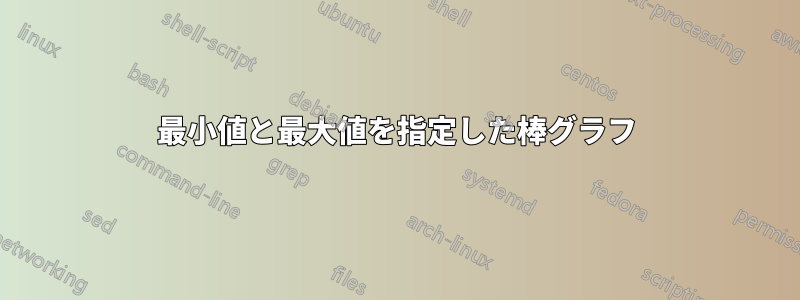
写真のような棒グラフを作成したいと思います。

各x値には、各バーの高さを表す最小値と最大値があります。しかし、私の問題は、最大値と最小値を指定してバーを作成する方法です。マニュアルでは、次のコードのように座標を指定してバーを作成する方法しか見つかりませんでした。
\begin{tikzpicture}
\begin{axis}[
x tick label style={
/pgf/number format/1000 sep=},
ylabel=Population,
enlargelimits=0.05,
legend style={at={(0.5,-0.15)},
anchor=north,legend columns=-1},
ybar interval=0.7,
]
\addplot
coordinates {(1930,50e6) (1940,33e6)
(1950,40e6) (1960,50e6) (1970,70e6)};
\addplot
coordinates {(1930,38e6) (1940,42e6)
(1950,43e6) (1960,45e6) (1970,65e6)};
\addplot
coordinates {(1930,15e6) (1940,12e6)
(1950,13e6) (1960,25e6) (1970,35e6)};
\legend{Far,Near,Here}
\end{axis}
\end{tikzpicture}
答え1
xこれについては、TikZ を利用することもできると思います。軸 (およびy)、バー (アスペクトと幅) をカスタマイズし、ラベル (xおよびy軸の両方に)を挿入できる解決策を以下に示します。
ここで例を示し、その後にコマンドに関する説明をいくつか示します。
完全な例では、異なるオプションを使用して同じグラフィックを 2 回表示します。
\documentclass[svgnames]{article} % the option is required for xcolor already called by tikz
\usepackage{xstring}
% Retreive an element from a list - Jake's code from
% http://tex.stackexchange.com/a/21560/13304
\newcommand*{\GetListMember}[2]{%
\edef\dotheloop{%
\noexpand\foreach \noexpand\a [count=\noexpand\i] in {#1} {%
\noexpand\IfEq{\noexpand\i}{#2}{\noexpand\a\noexpand\breakforeach}{}%
}}%
\dotheloop
\par%
}%
\usepackage{tikz}
\usetikzlibrary{calc,backgrounds}
\pgfdeclarelayer{gridlayer}
\pgfdeclarelayer{barlayer}
\pgfsetlayers{background,gridlayer,barlayer,main}
% Declarations
\pgfmathtruncatemacro\scaley{1}
\pgfmathtruncatemacro\scalex{1}
\pgfmathtruncatemacro\minycoord{-5}
\pgfmathtruncatemacro\step{1}
\pgfmathtruncatemacro\maxycoord{5}
\pgfmathtruncatemacro\minxcoord{-5}
\pgfmathtruncatemacro\maxxcoord{5}
\pgfmathsetmacro\barwidth{0.3}
\usepackage{xparse}
% Settings
\newcommand{\setyscale}[1]{\pgfmathtruncatemacro\scaley{#1}}
\newcommand{\setxscale}[1]{\pgfmathtruncatemacro\scalex{#1}}
\newcommand{\setminycoord}[1]{\pgfmathtruncatemacro\minycoord{#1/\scaley}}
\newcommand{\setmaxycoord}[1]{\pgfmathtruncatemacro\maxycoord{#1/\scaley}}
\newcommand{\setmaxxcoord}[1]{\pgfmathtruncatemacro\maxxcoord{#1/\scalex}}
\newcommand{\setminxcoord}[1]{\pgfmathtruncatemacro\minxcoord{#1/\scalex}}
\NewDocumentCommand{\setbarwidth}{m}{\pgfmathsetmacro\barwidth{#1}}
% Specific commands
\NewDocumentCommand{\drawbar}{o m m m o}{
\begin{pgfonlayer}{barlayer}
\draw[#1] ($(#2/\scalex,#3/\scaley)+(-\barwidth,0)$)rectangle($(#2/\scalex,#4/\scaley)+(\barwidth,0)$);
\end{pgfonlayer}
\IfNoValueTF{#5}{}{
\node[below, text width=\step cm,font=\footnotesize,align=flush center] at (#2/\scalex,#3/\scaley) {#5};
}
}
\NewDocumentCommand{\drawaxes}{O{stealth} m m}{
\pgfmathparse{add(\maxycoord,\step)}\pgfmathresult
\pgfmathtruncatemacro\finaly\pgfmathresult
\ifnum\minycoord=0
\draw[-#1,very thick](0,\minycoord)--(0,\finaly) node[left]{#3};
\else
\pgfmathparse{subtract(\minycoord,\step)}\pgfmathresult
\pgfmathtruncatemacro\startingy\pgfmathresult
\draw[#1-#1,very thick](0,\startingy)--(0,\finaly) node[left]{#3};
\fi
\pgfmathparse{add(\maxxcoord,\step)}\pgfmathresult
\pgfmathtruncatemacro\finalx\pgfmathresult
\ifnum\minxcoord=0
\draw[-#1,very thick](\minxcoord,0)--(\finalx,0) node[below right]{#2};
\else
\pgfmathparse{subtract(\minxcoord,\step)}\pgfmathresult
\pgfmathtruncatemacro\startingx\pgfmathresult
\draw[#1-#1,very thick](\startingx,0)--(\finalx,0) node[below right]{#2};
\fi
}
\NewDocumentCommand{\setlabelyaxes}{o O{0.1}}{
\pgfmathtruncatemacro\startingy\minycoord
\pgfmathparse{add(\startingy,\step)}\pgfmathresult
\pgfmathtruncatemacro\secondy\pgfmathresult
\pgfmathtruncatemacro\lasty\maxycoord
\IfNoValueTF{#1}{% true
\foreach \y [evaluate=\y as \scaledy using \y*\scaley] in {\startingy,\secondy,...,\lasty}
\pgfmathtruncatemacro\labely\scaledy
\draw[very thick] (#2,\y)--(-#2,\y) node[left] {\labely};
}{% false
\pgfmathparse{abs(subtract(\startingy,\lasty))}\pgfmathresult
\pgfmathsetmacro\dimyaxes\pgfmathresult
\foreach \axisitems [count=\axisitem] in {#1} {\global\let\totaxisitems\axisitem}
\pgfmathparse{subtract(\totaxisitems,1)}\pgfmathresult
\pgfmathtruncatemacro\numstep\pgfmathresult
\pgfmathparse{divide(\dimyaxes,\numstep)}\pgfmathresult
\pgfmathsetmacro\incrstep\pgfmathresult
\pgfmathparse{add(\startingy,\incrstep)}\pgfmathresult
\pgfmathsetmacro\seconditemy\pgfmathresult
\foreach \y [count=\yi] in {\startingy,\seconditemy,...,\lasty}
\draw[very thick] (#2,\y)--(-#2,\y) node[left]{\GetListMember{#1}{\yi}};
}
}
\NewDocumentCommand{\setlabelxaxes}{O{0.1}}{
% X-axis
\pgfmathtruncatemacro\startingx\minxcoord
\pgfmathparse{add(\startingx,\step)}\pgfmathresult
\pgfmathtruncatemacro\secondx\pgfmathresult
\pgfmathtruncatemacro\lastx\maxxcoord
\foreach \x [evaluate=\x as \scaledx using \x*\scalex] in {\startingx,\secondx,...,\lastx}{
\pgfmathtruncatemacro\labelx\scaledx
\pgfmathparse{notequal(\labelx,0)}\pgfmathresult
\ifnum\pgfmathresult=1
\draw[very thick] (\x,#1)--(\x,-#1) node[below] {\labelx};
\fi
}
}
\NewDocumentCommand{\setytickaxes}{O{0.1}}{
% Y-axis
\pgfmathtruncatemacro\startingy\minycoord
\pgfmathparse{add(\startingy,\step)}\pgfmathresult
\pgfmathtruncatemacro\secondy\pgfmathresult
\pgfmathtruncatemacro\lasty\maxycoord
\foreach \y[evaluate=\y as \scaledy using \y*\scaley] in {\startingy,\secondy,...,\lasty}{
\pgfmathtruncatemacro\labely\scaledy
\pgfmathparse{notequal(\labely,0)}\pgfmathresult
\ifnum\pgfmathresult=1
\draw[very thick] (#1,\y)--(-#1,\y);
\fi
}
}
\NewDocumentCommand{\setxtickaxes}{O{0.1}}{
% X-axis
\pgfmathtruncatemacro\startingx\minxcoord
\pgfmathparse{add(\startingx,\step)}\pgfmathresult
\pgfmathtruncatemacro\secondx\pgfmathresult
\pgfmathtruncatemacro\lastx\maxxcoord
\foreach \x [evaluate=\x as \scaledx using \x*\scalex] in {\startingx,\secondx,...,\lastx}{
\pgfmathtruncatemacro\labelx\scaledx
\pgfmathparse{notequal(\labelx,0)}\pgfmathresult
\ifnum\pgfmathresult=1
\draw[very thick] (\x,#1)--(\x,-#1);
\fi
}
}
\NewDocumentCommand{\drawgrid}{o}{
\pgfmathparse{add(\maxxcoord,\step)}\pgfmathresult
\pgfmathtruncatemacro\finalx\pgfmathresult
\IfNoValueTF{#1}{
\begin{pgfonlayer}{gridlayer}
\draw[help lines] (\minxcoord,\minycoord)grid(\finalx,\maxycoord);
\end{pgfonlayer}
}{
\begin{pgfonlayer}{gridlayer}
\draw[help lines,#1] (\minxcoord,\minycoord)grid(\finalx,\maxycoord);
\end{pgfonlayer}
}
}
\begin{document}
\begin{figure}
\centering
\begin{tikzpicture}[scale=0.8,transform shape]
% Customization of elements
\setyscale{200}
\setxscale{200}
\setminycoord{-1000}
\setmaxycoord{1000}
\setminxcoord{0}
\setmaxxcoord{1400}
\setbarwidth{0.4}
% Axes
\drawaxes{$x$}{$y$}
\setlabelyaxes[label one, label two,label three,label four,label five]
% Bars
\drawbar[top color=gray!10, bottom color=gray!70,thick]{200}{-250}{832}[label a]
\drawbar[top color=orange!10, bottom color=orange!70,thick]{400}{-300}{250}[label b]
\drawbar[fill=AliceBlue!40,thick]{600}{-600}{423}[label c]
\drawbar[top color=BlueViolet!5, bottom color=BlueViolet!70,thick]{800}{-450}{1000}
\drawbar[top color=white, bottom color=FireBrick!80,thick]{1000}{-71}{150}[label d]
\drawbar[top color=GreenYellow!10, bottom color=GreenYellow!70,thick]{1200}{-500}{733}[label e]
\drawbar[top color=Aqua!10, bottom color=Aqua!70,thick]{1400}{-361}{124}[label f]
\end{tikzpicture}
\caption{This a very long caption that incidentally could overwrite the y axis, but actually it doesn't}
\end{figure}
\begin{figure}
\centering
\begin{tikzpicture}[scale=0.8,transform shape]
% Customization of elements
\setyscale{200}
\setxscale{100}
\setminycoord{-1000}
\setmaxycoord{1000}
\setminxcoord{0}
\setmaxxcoord{700}
\setbarwidth{0.45}
% Axes
\drawgrid[dashed]
\drawaxes[latex]{my x axis}{my y axis}
\setlabelyaxes
\setxtickaxes
% Bars
\drawbar[top color=gray!10, bottom color=gray!70,thick]{100}{-250}{832}[label a]
\drawbar[top color=orange!10, bottom color=orange!70,thick]{200}{-300}{250}[label b]
\drawbar[fill=AliceBlue!40,thick]{300}{-600}{423}[label c]
\drawbar[top color=BlueViolet!5, bottom color=BlueViolet!70,thick]{400}{-450}{1000}
\drawbar[top color=white, bottom color=FireBrick!80,thick]{500}{-71}{150}[label d]
\drawbar[top color=GreenYellow!10, bottom color=GreenYellow!70,thick]{600}{-500}{733}[label e]
\drawbar[top color=Aqua!10, bottom color=Aqua!70,thick]{700}{-361}{124}[label f]
\end{tikzpicture}
\caption{The caption}
\end{figure}
\end{document}
で始まるコマンド\set<element>を使用すると、 をカスタマイズできます<element>。 グリッドは コマンドで描画でき\drawgrid、オプションの引数は\drawaxes軸を表示する際の外観をカスタマイズしますが、カスタマイズできるのは矢印のスタイルだけです。 のdrawaxes2 つのパラメータは必須で、これは軸を特徴付けるラベルです。
軸の目盛りとラベルを設定するコマンドがいくつかあります。これらは、軸xとでは異なります。目盛りだけを設定するには、 と を使用できますが、は目盛りだけでなく軸マークも挿入します。独自のラベルを挿入する必要がある場合は、 を使用できます。このモダリティは、リスト内の要素の数に基づいて軸の目盛りとラベルを表示します。2 つの例 (図はすぐに挿入されます) はこの違いを示しています。軸に相当するものはありません。その理由は、バーを描画するときにラベルを設定する方がはるかに簡単だと私は思うからです。これを行うコマンドは で、バーを描画するための位置、座標が必須の引数として必要です。オプションのパラメータとして、バーの外観をカスタマイズしたり、ラベルを挿入したりできます。したがって、このコマンドの構文は次のとおりです。y\setxtickaxes\setytickaxes\setlabelyaxessetlabelyaxis[<list of labels>]\setlabelyaxisxx\drawbarxyminymax
\drawbar[<customization>]{<x>}{<ymin>}{<ymax>}[<label>]
ここに 2 つの例の図があります (キャプションの問題は修正されています)。最初の例では、y軸ラベルが によって手動で挿入されており\setlabelyaxes[label one, label two,label three,label four,label five]、 x目盛りは表示されていません (個人的にはこの方法が好みです)。

画像が大きくなりすぎないようにするために環境[scale=0.8,transform shape]に与えられたオプションにも注意してください。tikzpicture
2 番目の例では、y軸ラベルが自動的に付与され、x目盛りがグリッドとして表示されます。

答え2
これを行うには、PGFPlots を使用できます。純粋な TikZ ソリューションと比較すると、大きな値のデータ スケーリングを処理し、さまざまな形式でデータを簡単に提供でき、自動凡例、目盛り、カラー サイクル リストなど、PGFPlots の多くの便利な機能を利用できるという利点があります。
forget plot列の負の部分と正の部分を分割し、負の部分に追加するだけです。

\documentclass[border=5mm]{standalone}
\usepackage{pgfplots}
\pgfplotstableread{
Year FarMin FarMax NearMin NearMax HereMin HereMax
1930 -20 50 -10 30 -15 40
1940 -10 60 -15 60 -20 70
1950 -15 78 -20 20 -32 42
1960 -20 30 -15 40 -20 10
1970 -5 30 -30 40 -15 20
}\datatable
\begin{document}%
\begin{tikzpicture}
\begin{axis}[
x tick label style={
/pgf/number format/1000 sep=},
ylabel=Population,
ybar,
enlarge x limits=0.15,
bar width=0.8em,
after end axis/.append code={
\draw ({rel axis cs:0,0}|-{axis cs:0,0}) -- ({rel axis cs:1,0}|-{axis cs:0,0});
}
]
\addplot +[forget plot] table {\datatable};
\addplot table [y index=2] {\datatable};
\addplot +[forget plot] table [y index=3] {\datatable};
\addplot table [y index=4] {\datatable};
\addplot +[forget plot] table [y index=5] {\datatable};
\addplot table [y index=6] {\datatable};
\legend{Far,Near,Here}
\end{axis}
\end{tikzpicture}
\end{document}
答え3
ここでは、モノクロまたはカラーのバー用の、ほぼ自動バージョンを示します。
コード
\documentclass[parskip]{scrartcl}
\usepackage[margin=15mm]{geometry}
\usepackage{tikz}
\usetikzlibrary{arrows}
\pgfdeclarelayer{background}
\pgfsetlayers{background,main}
\newcommand{\drawstacks}[3]% low/high value, baroptions, gridoptions
{ \xdef\minvalue{0}
\xdef\maxvalue{0}
\foreach \low/\high [count=\c] in {#1}
{ \fill[#2] (\c-0.8,\low) rectangle (\c-0.2,\high);
\xdef\stacknumber{\c}
\pgfmathsetmacro{\lower}{min(\minvalue,\low)}
\xdef\minvalue{\lower}
\pgfmathsetmacro{\higher}{max(\maxvalue,\high)}
\xdef\maxvalue{\higher}
}
\pgfmathtruncatemacro{\lowbound}{\minvalue}
\pgfmathtruncatemacro{\highbound}{\maxvalue}
\begin{pgfonlayer}{background}
\draw[#3] (0,\lowbound-1) grid (\stacknumber,\highbound+1);
\end{pgfonlayer}
\draw[thick,-latex] (0,0) -- (\c+0.5,0);
\draw[thick,-latex] (0,\lowbound-1) -- (0,\highbound+1.5);
\pgfmathtruncatemacro{\a}{\lowbound-1}
\pgfmathtruncatemacro{\b}{\highbound+1}
\foreach \x in {\a,...,\b}
{ \pgfmathtruncatemacro{\label}{\x}
\draw (0.07,\x) -- (-0.07,\x) node[left] {\label};
}
}
\newcommand{\drawcolorstacks}[2]% low/high/color, gridoptions
{ \xdef\minvalue{0}
\xdef\maxvalue{0}
\foreach \low/\high/\fillcolor [count=\c] in {#1}
{ \fill[\fillcolor,draw=\fillcolor!50!black] (\c-0.8,\low) rectangle (\c-0.2,\high);
\xdef\stacknumber{\c}
\pgfmathsetmacro{\lower}{min(\minvalue,\low)}
\xdef\minvalue{\lower}
\pgfmathsetmacro{\higher}{max(\maxvalue,\high)}
\xdef\maxvalue{\higher}
}
\pgfmathtruncatemacro{\lowbound}{\minvalue}
\pgfmathtruncatemacro{\highbound}{\maxvalue}
\begin{pgfonlayer}{background}
\draw[#2] (0,\lowbound-1) grid (\stacknumber,\highbound+1);
\end{pgfonlayer}
\draw[thick,-latex] (0,0) -- (\c+0.5,0);
\draw[thick,-latex] (0,\lowbound-1) -- (0,\highbound+1.5);
\pgfmathtruncatemacro{\a}{\lowbound-1}
\pgfmathtruncatemacro{\b}{\highbound+1}
\foreach \x in {\a,...,\b}
{ \pgfmathtruncatemacro{\label}{\x}
\draw (0.07,\x) -- (-0.07,\x) node[left] {\label};
}
}
\colorlet{cola}{red!50!gray}
\colorlet{colb}{orange!50!gray}
\colorlet{colc}{yellow!50!gray}
\colorlet{cold}{green!50!gray}
\colorlet{cole}{blue!50!gray}
\colorlet{colf}{violet!50!gray}
\colorlet{colg}{gray}
\begin{document}
\begin{tikzpicture}
\drawstacks{-2.1/4.3,-1.8/7.1,-5.6/3.7,-4.5/3.5,-3.9/2.0,-6.3/1.7,-1.8/2.4}{red!50,draw=red!50!black}{gray}
\end{tikzpicture}
\begin{tikzpicture}
\drawcolorstacks{-2.1/4.3/cola,-1.8/7.1/colb,-5.6/3.7/colc,-4.5/3.5/cold,-3.9/2.0/cole,-6.3/1.7/colf,-1.8/2.4/colg}{gray, thick, densely dotted}
\end{tikzpicture}
\end{document}
結果

高い値を描画するための新しいバージョンがあります。すべてのデータをプロット用に分割する新しいオプション パラメーターが追加されました。デフォルトは 500 ですが、変更できます。
コード
\newcommand{\drawhighstacks}[3][500]% low/high/color, gridoptions
{ \xdef\minvalue{0}
\xdef\maxvalue{0}
\foreach \low/\high/\fillcolor [count=\c] in {#2}
{ \fill[\fillcolor,draw=\fillcolor!50!black] (\c-0.8,\low/#1) rectangle (\c-0.2,\high/#1);
\xdef\stacknumber{\c}
\pgfmathsetmacro{\lower}{min(\minvalue,\low)}
\xdef\minvalue{\lower}
\pgfmathsetmacro{\higher}{max(\maxvalue,\high)}
\xdef\maxvalue{\higher}
}
\pgfmathtruncatemacro{\lowbound}{\minvalue/#1}
\pgfmathtruncatemacro{\highbound}{\maxvalue/#1}
\begin{pgfonlayer}{background}
\draw[#3] (0,\lowbound-1) grid (\stacknumber,\highbound+1);
\end{pgfonlayer}
\draw[thick,-latex] (0,0) -- (\c+0.5,0);
\draw[thick,-latex] (0,\lowbound-1) -- (0,\highbound+1.5);
\pgfmathtruncatemacro{\a}{\lowbound-1}
\pgfmathtruncatemacro{\b}{\highbound+1}
\foreach \x in {\a,...,\b}
{ \pgfmathtruncatemacro{\label}{\x*#1}
\draw (0.07,\x) -- (-0.07,\x) node[left] {\label};
}
}
結果
\begin{tikzpicture}
\drawhighstacks{-1632/927/cola, -412/1250/colb, -777/1965/colc, -1234/1984/cold, -981/1984/cole, -1004/590/colf, -766/1318/colg}{gray, thick, dashed}
\end{tikzpicture}
\begin{tikzpicture}
\drawhighstacks[300]{-1632/927/cola, -412/1250/colb, -777/1965/colc, -1234/1984/cold, -981/1984/cole, -1004/590/colf, -766/1318/colg}{gray, thick, dashed}
\end{tikzpicture}



